The Nobel Prize in Physics 2001
| The Nobel Prize in Physics 2001 | |||||||||||||
|
|
Cooling of alkali atoms towards BEC |
 |
|
||||||||||
| Based on materials from the 2001 Nobel Poster for Physics |
|
||||||||||||
Nobel Prizes and laureates
Six prizes were awarded for achievements that have conferred the greatest benefit to humankind. The 14 laureates' work and discoveries range from quantum tunnelling to promoting democratic rights.
See them all presented here.

